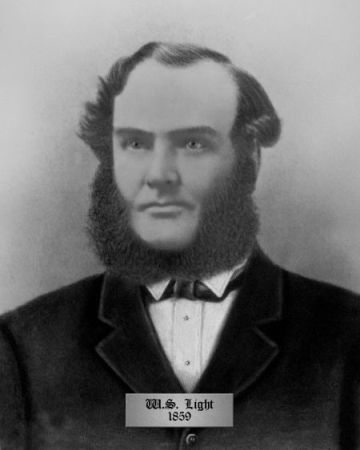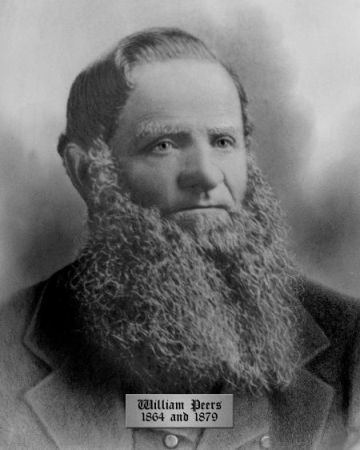Beards
Neck Beard
A neck beard is a beard that mainly includes neck hair and hair under the jaw being grown long beneath the chin, with little to no hair on the face. This style of beard became popular in the 1800s. Famous neck beard wearers included Jefferson Davis, President of the Confederate States from 1861 to 1865, 19th century German composer Wilhelm Richard Wagner, and American naturalist, poet, and philosopher Henry David Thoreau.
William S. Light – 1859 (North Oxford Township)
William S. Light first served on the District of Brock Council, beginning in 1846 and would first serve on the Oxford County Council in 1852. He would serve on County Council for the next 10 years, and was elected as Warden in 1859.
The Shenandoah
The Shenandoah is a fuller version of chin curtain facial hair, that is a beard with no mustache and hair grown only low on the cheeks, jaw, chin, and neck. This beard was commonly seen worn by men in Europe and North America in the 1800s and early 1900s. It is associated with the Amish community as well; Amish men grow a Shenandoah style beard once married.
William Peers – 1864 and 1879 (East Oxford Township)
Born in Lancashire England, William Peers lived at Concession 2, Lot 20 East Oxford Township. He would serve as Reeve of East Oxford Township from 1863 to 1866 and again from 1874 – 1880. He was elected Warden in 1864 and 1879. He would pass away on March 27, 1895 at the age of 88 years.
The French Fork
Despite being named “The French Fork” this beard style originates in the Middle East. The Persians commonly wore their beard split and curled at the ends. Arabic fashion and facial hair trends eventually became intertwined with Greek fashion after borders opened up between the 8th and 10th centuries following the weakening of the Byzantine Empire, this allowed for the trade of goods, fashion, culture and religion. The forked beard had its time in the limelight in Italy during the Renaissance of the 1400s. The forked beard had already been worn by Scandinavian and Viking men historically.
The beard is named after the two-pronged utensil that gained popularity in France in the 1530s. After the Italian Renaissance, this beard style lost popularity but reappeared again on the faces of German nobility during the 1800s and once again spread in popularity.
Gordon H. Cook – 1875 (West Oxford Township)
Gordon H. Cook was one of Oxford’s pioneers and prominent men. Born in 1832, he farmed on Lot 9, Concession 1 West Oxford Township. He first served on County Council in 1869, as Deputy Reeve, and would hold the position of Reeve for West Oxford Township, for a number of terms, over the next ten years. Mr. Cook would be elected Warden in 1875.
Following his municipal political career, he would serve as license inspector for South Oxford for twenty-six years (1876-1903). He was also connected with the Ingersoll, North and West Oxford Agricultural Society. The Woodstock Sentinel-Review declared him as “a man of sterling integrity and fine personality, [who] enjoyed the esteem of a very wide circle of acquaintances in both North and South Oxford (W-SR, FP March 8, 1907). He would pass away on March 8, 1907.
The Garibaldi Beard
The Garibaldi beard is a full, wide beard with a rounded shape and an integrated mustache. The beard style is named after General Giuseppe Garibaldi, an Italian General who aided in the unification of modern Italy in the 1800s. He was known as an esteemed military man and so this masculine style carries his name.
John Peers – 1884 (East Oxford Township)
Born in Oxford County, on what was later known as the Boyle farm (the boyhood home of Joe “Klondike” Boyle), John Peers would purchase property, south east of the City of Woodstock (later the home of M.P. Malcolm Schell) where he farmed for a number of years. He was a valued member of County Council from 1878 to 1890, serving as Deputy Reeve and Reeve, and was elected Warden in 1884. He also served as church warden of Old St. Paul’s Church, Woodstock for 25 years. John Peers would pass away August 24, 1910, in Woodstock, as the age of 75, following a long illness.
Ducktail Beard
The Ducktail, named after the shape of a duck’s tail, is a style of pointed beard that was popularly worn by “men of intellect” in the 1870s to 1910s. The carefully shaped beard added a touch of refinery to this style of beard which set it apart from other styles.
Donald R. Calder – 1893 (East Nissouri Township)
Donald R. Calder served as Deputy Reeve of East Nissouri Township in 1889 and would serve as Reeve from 1890 to 1894. He was elected Warden in 1893.





